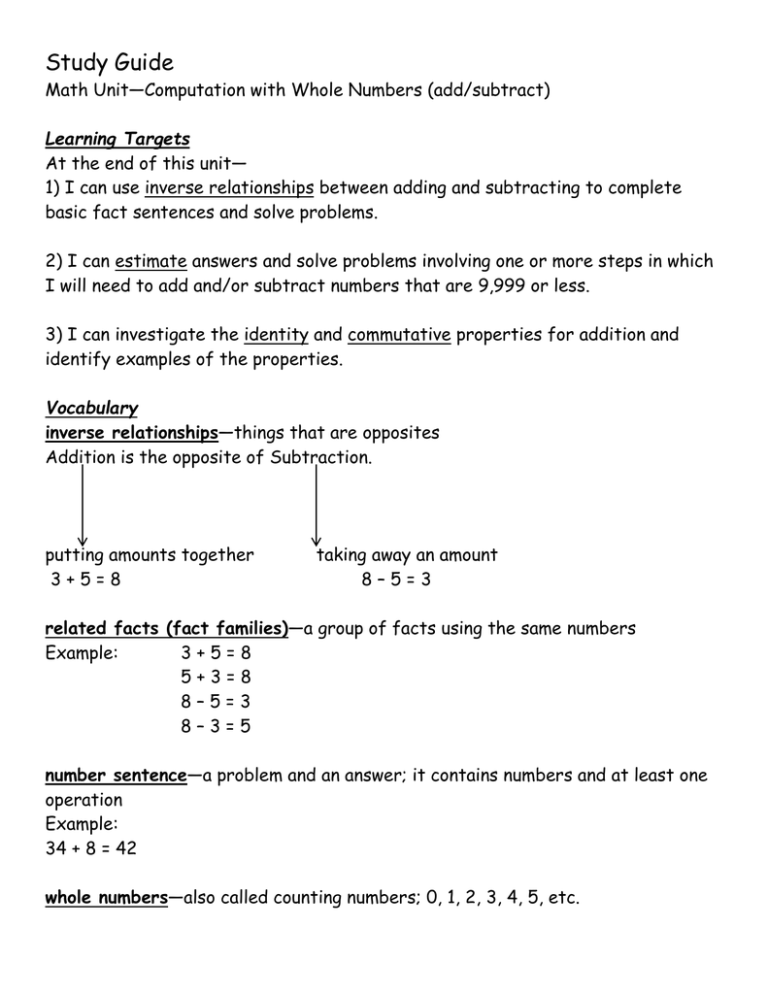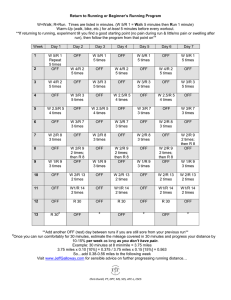Study Guide
advertisement

Study Guide Math Unit—Computation with Whole Numbers (add/subtract) Learning Targets At the end of this unit— 1) I can use inverse relationships between adding and subtracting to complete basic fact sentences and solve problems. 2) I can estimate answers and solve problems involving one or more steps in which I will need to add and/or subtract numbers that are 9,999 or less. 3) I can investigate the identity and commutative properties for addition and identify examples of the properties. Vocabulary inverse relationships—things that are opposites Addition is the opposite of Subtraction. putting amounts together 3+5=8 taking away an amount 8–5=3 related facts (fact families)—a group of facts using the same numbers Example: 3+5=8 5+3=8 8–5=3 8–3=5 number sentence—a problem and an answer; it contains numbers and at least one operation Example: 34 + 8 = 42 whole numbers—also called counting numbers; 0, 1, 2, 3, 4, 5, etc. sum—the answer when you add numbers together difference—the answer when you subtract numbers estimate—to give an approximate number or answer; to tell about how many addend—the numbers that are added together to get a sum Example: 34 + 81 = 115 34 and 81 are addends in this number sentence. commutative property—in addition, numbers can be added in any order and the sum is still the same Example: 4+5=9 5+4=9 identity property—the sum of any number and zero is that same number. Example: 5+0=5 Skills Each student should be able to: 1) Use inverse relationships: If I know that 4 + 3 = 7, that will help me to figure out 7 – 3 = _____. 2) Write the 4 facts that make up a fact family: 3 + 8 = 11 8 + 3 = 11 11 – 3 = 8 11 – 8 = 3 3) Estimate answers when adding and subtracting: 28 30 + 61 +60 28 rounded to the nearest 10 is 30. 61 rounded to the nearest 10 is 60. 30 + 60 = 90 90 is the estimated answer to 28 + 61 4) Add and subtract 4-digit numbers: 3,581 + 1,687 4,268 4,509 - 3,276 1,233 Methods of adding and subtracting: regrouping 1 1 4 10 3,581 4,509 + 1,687 - 3,276 5,268 1,233 break apart strategy for addition 3,581 + 1,687 8 160 1,100 + 4,000 5,268 (1 + 7) (80 + 80) (500 + 600) (3,000 + 1,000) 5) Understand the meaning of commutative property and identity property. Give examples of each: 2 + 8 = 10 and 8 + 2 = 10 is an example of the commutative property. 2 + 0 = 0 is an example of the identity property. 6) Solve problems that require addition and subtraction: Tom is going on a trip. He will travel 43 miles from Washington, D.C. to Baltimore, Maryland. Then he will travel 98 miles from Baltimore to Philadelphia, Pennsylvania. Finally, he will travel 94 miles from Philadelphia to Hershey, Pennsylvania. He wants to find out about how many miles he will travel in all. About how many miles will he travel? 43 rounds to 40 98 rounds to 100 94 rounds to 90 40 + 100 + 90 = 230 miles Tom will travel about 230 miles. Exactly how many miles will he travel? 43 + 98 + 94 = 235 Tom will travel exactly 235 miles.



